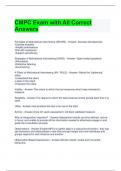CMPC Exam with All Correct
Answers
Principles of Motivational Interviewing (DEARS) - Answer--Develop discrepancies
-Express empathy
-Amplify ambivalence
-Roll with resistance
-Support self-efficacy
Strategies of Motivational Interviewing (OARS) - Answer--Open-ended questions
-Affirmations
-Reflective listening
-Summarizing
4 Pillars of Motivational Interviewing (MI - RULE) - Answer--Resist the "rightening"
reflex.
-Understand the client.
-Listen to the client.
-Empower the client.
Validity - Answer-The extent to which the test measures what it was intended to
measure.
Reliability - Answer-The degree to which the test produces similar scores each time it is
used.
Utility - Answer-How practical the test is for use in the field.
Ad hoc - Answer-Once-off, quick assessment, not been validated measure.
Why is triangulation important? - Answer-Assessment results are time-defined, narrow
in focus, and unable to provide all the information needed to effectively engage in and
guide the consultation process.
Observations - Answer-Enable MPCs to gather data in a natural environment - they can
see behaviors and relationships in real-time and get insight into how individuals and
groups respond to and influence one another.
Observation-Based Assessment - Answer-Monitor clients' verbal and nonverbal
behaviors.
,Proxemics - Answer-How interpersonal relationships and behaviors are changed by the
distance between two people.
Kinesics - Answer-Encompasses factors such as posture, touching, body movements,
gestures, eye movement, and facial expressions.
Paralanguage - Answer-Includes indicators of clients' mental status such as speech
pattern, rate, rhythm, volume, tone, and pitch.
Case Formulation - Answer-Comprises the organization and conceptualization of the
relevant case material.
Multilevel Classification System for Sport Psychology - Answer-Elements help increase
MPCs' understanding of the relationship between thoughts, emotions, behaviors, and
consequences.
Elements of Multilevel Classification System for Sport Psychology - Answer--Contextual
performance demands
-Skill level
-Situational demands
-Transitional, developmental, and psychosocial stressors
-Performance and nonperformance schemas
-Attentional focus
-Cognitive processes
-Affective responses
-Behavioral responses
Sport Psychology Service Delivery (SPSD) Heuristic - Answer--Professional boundaries
-Professional philosophy
-Making contact
-Assessment
-Conceptualizing athletes' concerns and potential interventions
-Range, types, and organization of service
-Program implementation
-Managing the self as an intervention instrument
-Program and consultant evaluation
-Conclusions and implications
-Leaving the setting
Mental Skills - Answer-Psychological abilities that facilitate athletes' performance and
personal development (e.g., motivation, self-confidence, attentional focus, arousal
regulation, and mindfulness).
Counseling - Answer-The skilled and principled use of a professional relationship to
empower individuals to achieve mental health, wellness, education, and career goals. It
,aims to facilitate self-knowledge, emotional acceptance and growth, and the optimal
development of personal resources.
Consulting - Answer-The overall aim of consulting is to facilitate the development of
mental and emotional skills, attitudes, perspectives, strategies, and processes that lead
to optimal performance, well-being, and personal growth.
Transtheoretical Model - Answer-A stages of change model that illustrates how behavior
changes over time, progressing through six discrete stages: precontemplation,
contemplation, preparation, action, maintenance, and termination
Pre-contemplation - Answer-Individuals are unaware or uninformed of the need to
change behavior and have no intentions of changing.
Importance of highlighting benefits of MST and building trust.
Contemplation - Answer-Individuals recognize the importance of behavior change and
are committed to taking action to change their behavior in the next six months.
Increasing awareness of unhelpful behaviors and highlighting benefits of behavior
change.
Preparation - Answer-Individuals are planning to change their behavior and are
committed to following through.
Athlete has a plan/goal/timeline (ideally with support from MPCs).
Action - Answer-Individuals are implementing their plan and making behavior
modifications, typically for less than six months.
Athletes in this stage would be working with an MPC and engaging in mental skills
training.
Maintenance - Answer-Individuals' changed behaviors become established in their daily
life, typically for more than six months.
In sport, athletes in this stage would consistently apply the mental skills and techniques
they have learned.
Termination - Answer-Individuals are 100 percent self-efficacious in engaging in the
new behaviors and have no temptation to relapse.
In sport, athletes would be effectively and effortlessly applying mental skills in a variety
of situations and have no risk of regressing to earlier stages.
Theory of Planned Behavior - Answer-Proposes that the key factor influencing change
is the INTENTION to perform the behavior.
This intention is driven by underlying motivation, individuals' attitude toward the
behavior, subjective norms (i.e., perceived social pressure to engage in the behavior),
and perceived behavioral control (i.e., expectancy that performance of the behavior is
within their control).
, Person Centered Therapy (PCT) - Answer-A humanistic, client-centered approach
driven by a positive and phenomenological view of humans.
Focuses on the desires and strengths of human beings to reach their full potential and
to self-actualize with the aim of leading individuals toward high-level functioning and
personal fulfillment.
Therapeutic Alliance - Answer-the bond or connection that develops between a
practitioner and client.
Factors of PCT - Answer-Unconditional positive regard, empathy, and genuineness
Existential Therapy (ET) - Answer-Relies on concepts that are universally applicable to
human existence. It aims to address and understand issues of freedom and
responsibility, isolation and relationships, meaning and meaninglessness, and living and
dying.
ET counselors help clients search for... - Answer-meaning, purpose, values, and goals.
Emotion-Focused Therapy (EFT)So - Answer-Designed to help clients recognize and
productively use their emotions. Clients learn to identify, experience, accept, express,
explore, transform, and manage their emotions.
Solution-Focused Brief Therapy (SFBT) - Answer-A future-focused, goal-oriented
approach that emphasizes clients' strengths and resilience.
SFBT Techniques - Answer-Questioning (e.g., miracle, exception, and scaling
questions), interpretation, and reframing (i.e., restorying), feedback, encouragement,
homework, evaluation of progress.
When can SFBT be used? - Answer-In critical, time-sensitive situations where athletes
or performer must find quick solutions to challenges
Behavior Therapy - Answer-Based on the work of Pavlov and Skinner and the famous
principles of classical and operant conditioning.
Classical Conditioning - Answer-Originally proposed by Ivan Pavlov, refers to the
learning that occurs in response to a stimulus through pairing (e.g., bell rings, dog
salivates).
"beethoven is classic"
Operant Conditioning - Answer-Skinner: behavior is reinforced by the events that
directly follow it.
Social Cognitive Approach - Answer-Bandura: emphasized the interactive roles of the
environment, the person, and behavior.




